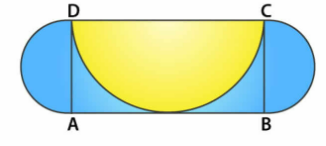In Figure, ABCD is a trapezium of area 24.5 cm2 . In it, AD∣∣BC , ∠DAB=90∘ , AD=10 cm and BC=4 cm . If ABE is a quadrant of a circle, find the area of the shaded region. (Take π=22/7) .
To solve the problem step by step, we will follow the given information and apply the relevant formulas.
Step 1: Understanding the trapezium
We have a trapezium ABCD where:
- AD∥BC
- ∠DAB=90∘
- AD=10cm
- BC=4cm
- Area of trapezium ABCD=24.5cm2
Step 2: Using the area formula for trapezium
The area A of a trapezium can be calculated using the formula:
A=12×(b1+b2)×h
where b1 and b2 are the lengths of the parallel sides and h is the height.
Here, b1=AD=10cm, b2=BC=4cm, and the area A=24.5cm2.
Substituting the values into the area formula:
24.5=12×(10+4)×h
24.5=12×14×h
24.5=7h
h=24.57=3.5cm
Step 3: Finding the area of the quadrant ABE
The area Aquadrant of a quadrant of a circle can be calculated using the formula:
Aquadrant=θ360∘×πr2
where θ is the angle of the quadrant (which is 90∘) and r is the radius.
Here, the radius r=AB=h=3.5cm.
Substituting the values into the area formula:
Aquadrant=90360×227×(3.5)2
Aquadrant=14×227×12.25
Aquadrant=22×12.2528
Aquadrant=270.528=9.625cm2
Step 4: Finding the area of the shaded region
The area of the shaded region can be found by subtracting the area of the quadrant from the area of the trapezium:
Ashaded=Atrapezium−Aquadrant
Ashaded=24.5−9.625=14.375cm2
Final Answer
The area of the shaded region is 14.375cm2.
---
We have a trapezium ABCD where:
- AD∥BC
- ∠DAB=90∘
- AD=10cm
- BC=4cm
- Area of trapezium ABCD=24.5cm2
The area A of a trapezium can be calculated using the formula:
A=12×(b1+b2)×h
where b1 and b2 are the lengths of the parallel sides and h is the height.
24.5=12×(10+4)×h
24.5=12×14×h
24.5=7h
h=24.57=3.5cm
The area Aquadrant of a quadrant of a circle can be calculated using the formula:
Aquadrant=θ360∘×πr2
where θ is the angle of the quadrant (which is 90∘) and r is the radius.
Aquadrant=90360×227×(3.5)2
Aquadrant=14×227×12.25
Aquadrant=22×12.2528
Aquadrant=270.528=9.625cm2
The area of the shaded region can be found by subtracting the area of the quadrant from the area of the trapezium:
Ashaded=Atrapezium−Aquadrant
Ashaded=24.5−9.625=14.375cm2
The area of the shaded region is 14.375cm2.
Topper's Solved these Questions
Similar Questions
ABCD is a flower bed. If OA=21 m and OC=14 m , find the area of the bed. (Take π=22/7)
View SolutionIn Figure, ABCD is a trapezium with AB∣∣DC and ∠BCD=60∘ . If BFEC is a sector of a circle with centre C and AB=BC=7 cm and DE=4 cm , then find the area of the shaded region (Use π=227 and √3=1.732) .
View SolutionIn Figure, ABCD is a trapezium with AB∣∣DC . If △AED is similar to △BEC , prove that AD=BC .
View SolutionIn Fig. 32, ABCD is a rectangle of length AB=40 cm and breadth BC=25 cm. If P,Q,R,S be the mid-points of the sides AB, BC, CD and DA respectively, find the area of the shaded region.
View SolutionIn Figure, ABCD is a quadrilateral in which diagonal AC=84 cm ; DL⊥AC, BM⊥AC, DL=16.5 cm and BM=12 cm . Find the area of quadrilateral ABCD.
View SolutionIn Fig. 15.93, ABCD is a rectangle with AB=14 cm and BC=7 cm . Taking DC, BC and AD as diameters, three semi-circles are drawn as shown in the figure. Find the area of the shaded region.

View SolutionIn Figure, ABCD is a trapezium in which AB=7cm, AD=BC=5cm, DC=X cm, and distance between AB and DC is 4cm . Find the value of X and area of trapezium ABCD
View SolutionIn Figure, ABCD is a rectangle with sides AB=10cm and AD=5cm. Find the area of △EFG
View SolutionIn Figure, from a rectangular region ABCD with AB=20 cm , a right triangle AED with AE=9 cm and DE=12cm , is cut off. On the other end, taking BC as diameter, a semicircle is added on outside the region. Find the area of the shaded region. (Use π=22/7)
View SolutionIn Figure, ABCD is a parallelogram, AE ⊥DC and CF⊥AD . If AB=16CM, AE=8cm and CF=10cm, find AD
View Solution
